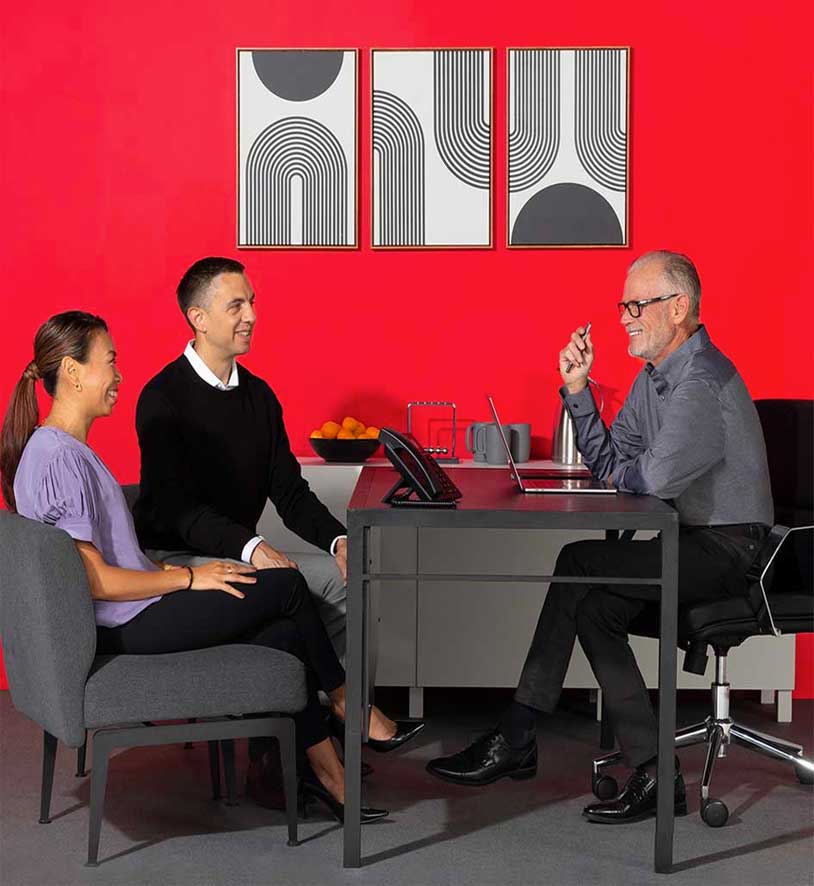Work from Home Office Essentials

7 Work from Home Office Essentials and Super Practical Tips
Whether you’re new to working from home or you’re a seasoned telecommuting pro, having work-from-home office essentials in place sets you up for success.
In the chapters below, discover what you need for a home office to do your best work and get practical self-care tips to enjoy a successful remote-working life.

Learn more about how Ooma Office can help your business.
Thank you!
An Ooma Office Sales Representative will be in touch shortly.
866-573-0707


Learn more about how Ooma Office can help your business.
Just call 877-621-0515 or click this to CHAT. Or, fill out this form and someone will reach out to you shortly.
Table of Contents
Part I: Prioritize getting your home office essentials.
Part II: Take care of your remote-working self.
Part I:
Prioritize getting your home office essentials
When you were working at the office, you probably didn’t think that much about the furniture. The desk’s laminate finish was okay, and the chair, while not a Herman Miller, it did the job.
As you set up your home office (and work with your employer to get your office necessities), the following tips will take the guesswork out of the process.
1. Define and create your at-home workspace
Whether you’re behind closed doors in your home office, co-working from your living room with your roommates, or sharing the dining table with your spouse and kids, creating a designated workspace is critical for being productive and staying sane.
Claim your work-from-home “real estate”
You will spend many hours in your new work area. To create consistency in your workday and help you transition in and out of work-mode, you need a place that signals, “This is where I work.”
- Define your work area and personalize it as you would at the company office — photos from your trip, your favorite chipped mug and your go-to pen.
- Set some ground rules for the household — let the kids know that your home office is off-limits or that the small desk in the living room is for your stuff only.
Talk to the kids about “when you’re working”
If you have children at home (especially young ones), your workday will change. They will interrupt you. They may even bomb your video call. It’s one of the hazards of working where you live.
However, putting a few rules in place will reduce the interruptions, give the kids much-needed boundaries during the workday, and help everyone stay happy.
Decrease interruptions and increase productivity with this visual cue.
Wear headphones to signal that you’re working. The visual cue will let family members know that you must not be disturbed.
Also, wearing headphones is an effective way to get into your work headspace — once the headphones go on, you’re working. They come off for breaks and at the end of the day.

Layout your workspace
When you worked on-site, you probably didn’t have much flexibility as to the layout of your space. If you worked in a cubicle, you maybe had your back to the doorway or sat sideways to the opening.
Have you noticed that some desk arrangements feel better than others? Some office setups feel welcoming, while others don’t?
Think about how you’d like to set up your desk and work area. Do you like to face a wall, in the corner (maybe this setup helps you tune out distractions)?
If you have some space to play with, follow the “command position” design rule of facing the door. The most beneficial desk placement allows you to see the door, suggests The Spruce.
Ideally, put your desk between you and the door. Avoid facing the door directly. Instead, situate your desk diagonally across from the entrance. If possible, sit with a solid wall behind you.
This placement allows you to see anyone entering the room (vital if you’re doing an important video call with small children around).
Additionally, the solid wall behind you creates a ready-to-go backdrop for video calls (make sure you remove any clutter or overly personal items).

Set up a go-to video conferencing spot
If you’re new to working from home, video calls will play a crucial role in connecting with colleagues and customers.
Your home space also presents some video-call challenges — the dog barking, the garbage truck roaring by or the kids playing.
To get the most out of your virtual meetings — to look and feel video-ready at a moment’s notice — you can follow some simple video-call tips. That might include, arriving early to a call, adjusting the lighting, simplifying your background (or using a virtual background) and doing a quick mirror check before you join the meeting.
2.
Deck out your remote work area
Even if your at-home work area is tiny, you can make it feel inviting and comfortable. You will spend a lot of time at your desk and on your computer, so it’s a good idea to get what you need as soon as possible.
Talk to your employer about what the company will supply and their process (including reimbursement and cost guidelines).
Invest in an ergonomic desk and chair
If buying a new desk is an option, consider choosing a desk that adjusts from seated to standing. Being able to switch positions can help you stay alert and comfortable.
Select a chair that provides good support and padding (you spend many hours every day in a seated position, so if there’s one piece of furniture to splurge on, this is it.)
Get a good light
If possible, choose a lamp that you can adjust to reduce eyestrain. You may prefer low light at certain times of the day (like early morning) and a brighter light in the evening.
Additionally, an easy-to-adjust light will allow you to create a more professional setting for video calls.
Stock up on and organize home office equipment
Make sure you have all the supplies you need for the day. From a stapler to a phone stand, having your go-to items on hand will help you stay on task.
3. Get the tech you need
As you jump into remote working, you’ll need reliable technology (especially if you have limited access to your IT people). Talk to your manager about home office tech essentials they’ll provide, as well as the support you can expect.

Test your internet connection
As video becomes the go-to communication tool for working from home, having a fast, strong internet connection is critical.
Need to check your internet speed? A search for “internet speed test” will provide you with many testing-app options.
By running the test, you’ll get an idea of your internet capabilities, such as:
- Download speed — how fast information transfers to you (e.g., images or large files).
- Upload speed — how fast information travels from you (e.g., posting images on social media).
- Latency — how quickly you receive information from a server. For example, a low response time results in better video-call quality.
Transfer your IP phone to home
If you used an internet protocol (IP) phone at the office, your company might transfer the VoIP phone service and IP handset to your home.
As long as you have a power source and internet connection, you can start using your phone immediately — just as did at your work location.

VoIP features that can make working from home feel ‘normal’
Depending on the service your company offers, you may want to request phone functions to help you sound your professional best.
- Virtual receptionist: Program the virtual receptionist to manage all your calls 24/7.
- Business phone mobile app: Use the business phone app to receive calls on your mobile phone. When calling out, the recipient’s caller ID will show your business number.
- Ring groups: Your company can set up multiple phones (including your home-office phone) to ring simultaneously (e.g., to all the sales reps) or sequentially.
- Conference lines: Activate conference lines to help teams collaborate.
Choose the best device for your work needs
What devices do you need to manage your daily tasks? The desktop you used at work might not be practical for a smaller home office, making a laptop a better choice.
Weigh up your options, taking your new, at-home work environment into consideration.
Laptop advantages for working from home
A laptop will give you the flexibility to work anywhere in your home. Moreover, the smaller size will make working in tighter spaces easier.
As a bonus, in the event of a power outage, a laptop will continue to run on battery power.
Desktop advantages for working from home
Your desktop will give you better screen options (e.g., size and definition) and processing-power choices.
Also, a desktop tends to be fixed in place, making connecting to the internet via ethernet cable feasible. Being connected via ethernet will ensure a robust and reliable connection.
Part II:
Take care of your remote-working self
Working from home is an adjustment, including a dramatic shift in daily routines. Water cooler moments are gone. Dropping by a colleague’s cubicle — gone. Me-time on the commute — gone.
Even if you’re in the “I’ve got this!” camp, the stress of working “alone” in your home environment can creep up on you.
Creating structure for yourself from the beginning helps.
Here are some practical tips that, like a rudder, will help to keep you on track as you navigate your new work environment.
4.
Power up your productivity
The very nature of work demands a schedule. Your home environment, however, not as much. When the two come together, work and life boundaries can blur. You may find yourself working through dinner and late into the night or starting your workday after “Okay, one more coffee.”
To increase your WFH productivity, it’s critical to make (and stick to) a routine.
Get dressed for work
Dressing down is one of the perceived benefits of working from home. However, working in your pajamas and not taking care of personal grooming (e.g., showering and brushing your hair) detracts from feeling prepared and professional.
Create a habit of getting dressed for work every morning (unless your company requires a particular dress code, comfortable business casual is acceptable).
Feeling “put together” will set a positive tone for your day while ensuring that you’re always video-call ready.
Define your work hours
With no one to hold you accountable for physically showing up, it’s easy to fall into the trap of working random hours without any beginning or end to your day.
The lack of structure can affect productivity, leading to rushed work and possibly compromising your work quality. Set your hours — your start and finish times — as well as allowing time for lunch and breaks.

Create a daily checklist
Working at home can be a productivity challenge. Take a few minutes at the start of the day to create your task list. Use the list to keep your workflow and productivity moving forward.
Get into the habit of checking off items as you go. You’ll know exactly “what’s next” versus winging it or discovering you’ve missed an important detail.
Manage distractions
Start by identifying the things that distract you. If you find alerts on your phone or computer difficult to ignore, you’re probably losing more time than you think.
For instance, you see an email alert. You stop working and go to your inbox. Before long, you’re scrolling through memes or adding stuff to your online shopping cart.
The key is to identify any distractions and create a routine for managing them. So, before you start working, close any unnecessary tabs and turn off your computer and phone alerts.

Take breaks (often)
Working at your computer can turn into hours of sitting in one place, staring at the screen. Your brain needs regular breaks to stay productive. People use varying time management strategies.
One popular strategy is the Pomodoro method. It emphasizes taking breaks (by setting a timer or using an app). You might work for 30 minutes then take a five-minute break.
The time intervals are up to you. Getting up out of your chair and moving away from the computer — just for a couple of minutes — can improve your focus and productivity.
Recap your day and preview tomorrow
By the time you finish your day, you may be tired and ready to relax. Before you wrap things up, take a few minutes to evaluate what you got done (that’s where the checklist comes in handy).
Move any incomplete tasks to tomorrow’s checklist and get a big-picture view of what to prioritize for the next day. Taking a few minutes to close out the day will help you “turn off work” for the evening and feel more prepared as you start your day.
5.
Pay attention to your health and well-being
Staying healthy while working from home may require extra effort and a new approach to taking care of yourself.
Without the daily activity of commuting to work, moving around the office or ducking out to grab lunch, your activity levels and social interactions will change.
Identify and combat loneliness from the beginning
As you adjust to working from home, you may not notice at first how much you miss interacting with your colleagues — from chatting at the photocopier to meeting up for happy hour.
Practicing self-care is a vital part of working alone at home.
Identify your social needs early
Are you an introvert or an extravert? Maybe both? If you’re an introvert, being home — away from social dynamics of the office — may energize you. An extravert, however, may find the solitude unsettling.
As you transition into the remote way of working, think about the work-from-home social activities you can do to feel happier and not feel lonely.
Create a work-from-home social plan
When you’re working from home, you have to create opportunities to socialize — schedule times to talk to colleagues, friends, and family.
Up your social networking game
If your org encourages social interactions as a way to cultivate a connected employee community (and in the past, you haven’t participated much), this is an excellent time to stretch your social networking wings.
Participating on your company’s social platforms (such as Yammer or Facebook) can boost morale, keep you connected to your work community, and provide opportunities to get to know your online colleagues.
Does your department share #mynewdesk pics or run a friendly #catsversusdogs photo competition? For a quick morale pick-up, take some time out to get involved in the fun activities your company offers.
Managing stress
Working from home may seem less stressful than commuting to work, navigating office dynamics and managing a full workload.
However, the home environment presents new challenges — from balancing work and family in one place to feeling less productive without the routine activity of the office.
Audit your stress level early
When you start working remotely, the goal is to make a seamless transition. However, working from home is a significant change and may cause pressures that go undetected.
While stress is a normal part of life, if tension escalates or goes unchecked, it can affect your physical and mental health.
A quick audit might start with noting routine differences (such as not sleeping or eating well) then identifying and decreasing stressors that are possibly causing the problems.

Exercise every day
“Get moving to manage stress,” suggests the Mayo Clinic. As you exercise (whether you run marathons or do yoga), your brain releases endorphins — neurotransmitters that make you feel good.
Regular exercise also works as an “active” meditation. You may notice that with a brisk walk or several sets of body-weight exercises (such as push-ups, burpees or lunges), the tension from the day will diminish as you shift your focus to working out.
Your exercise routine doesn’t have to be complicated or difficult. You just have to start! (talk to your doctor before starting a new exercise program).
Unwind with analog activities
To truly unwind, step away from your workspace — just as you would the office — and do something that doesn’t include a screen.

If you have children, do hands-on activities with them. Set up your supplies as well as theirs — roll modeling clay, cut out pictures, color with pencils in a coloring book.
No kids? Explore non-screen activities — write, draw, build, cook, garden. “Going analog” gives your eyes and brain a break from the online, connected world that you operate in throughout the day. It also provides sensory opportunities (that you don’t get from a screen).
6.
Create a strategy for managing your remote teams
Working from home as a manager will require some adjustments, including addressing issues virtually. Without in-office face-to-face interactions, communication may slow your ability to solve problems.

Alternatively, if your staff is readily available via phone, messaging or video, you might be able to fix a problem faster than in person.
Manage your remote team like a pro
If working from home includes managing employees remotely, clear communication is critical. That includes defining your employees’ and your availability.
What are the expectations for making and receiving business calls?
For instance, video meetings and conference calls are vital to doing business remotely. But how much is too much?
The instinct is to do more — to keep everyone connected (and decrease loneliness). Is that the best approach?
Ask your employees how they feel about the meetings — a quick one- or two-question survey (using a survey app or email) will provide valuable insight to help you create a positive work experience for everyone.
For example:
- What do you like and dislike about our video calls?
- What would make our virtual meetings better, more productive?
Rethink tasks that don’t seem work-from-home friendly
As more businesses move online, people are finding new ways to operate remotely.
Real estate companies are offering comprehensive virtual tours, cheese shops are doing virtual cheese mongering, and healthcare providers are seeing patients for routine medical appointments via video calls.
Is there a way to restructure tasks that are usually done in person — make them work just as well (or better) in the virtual setting?
Build a supportive, collaborative work-from-home community
As a remote-worker manager, your teams will need your support. That includes cultivating a community and providing opportunities for staff to collaborate on their work and get valuable feedback.
Ultimately, a supportive online work environment will improve employee retention and benefit everyone — from leadership to new hires.
7. Get your work-from-home essentials and self-care routine down
Whether you’ve been planning for a while to work remotely or had to work from home unexpectedly, adapting to your new work situation may take some time and effort.
However, with a thoughtful workspace setup, defined hours and consistent self-care, these work from home office essentials can help you create a rewarding and enjoyable way to work.

